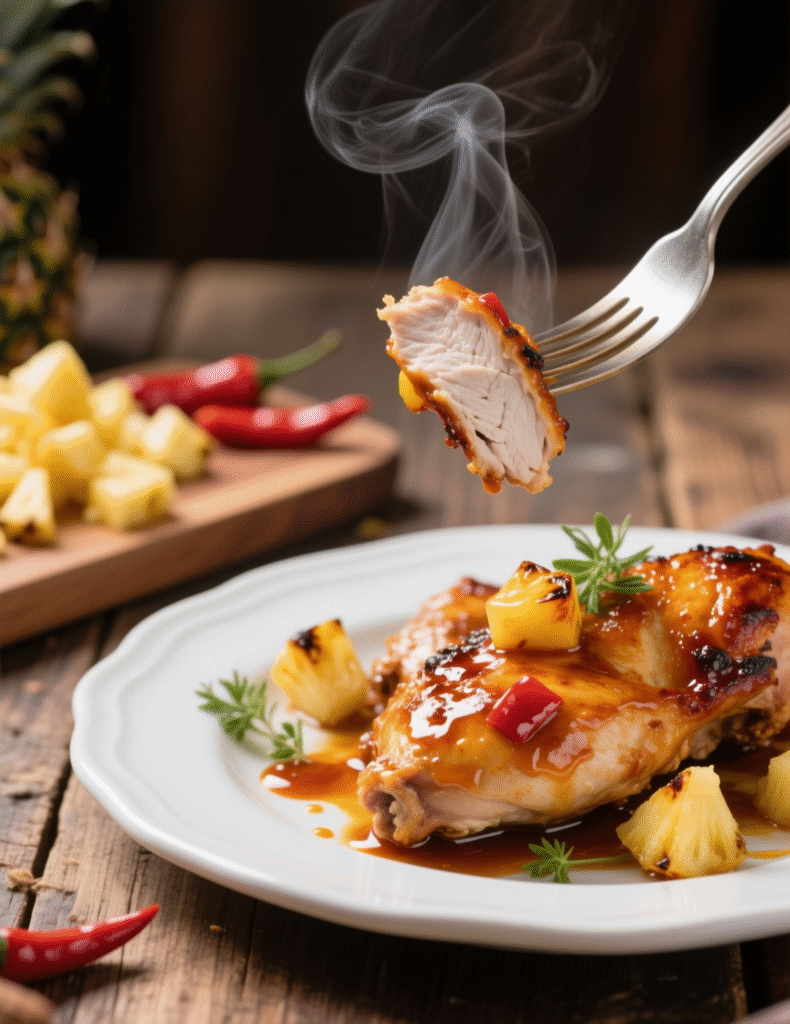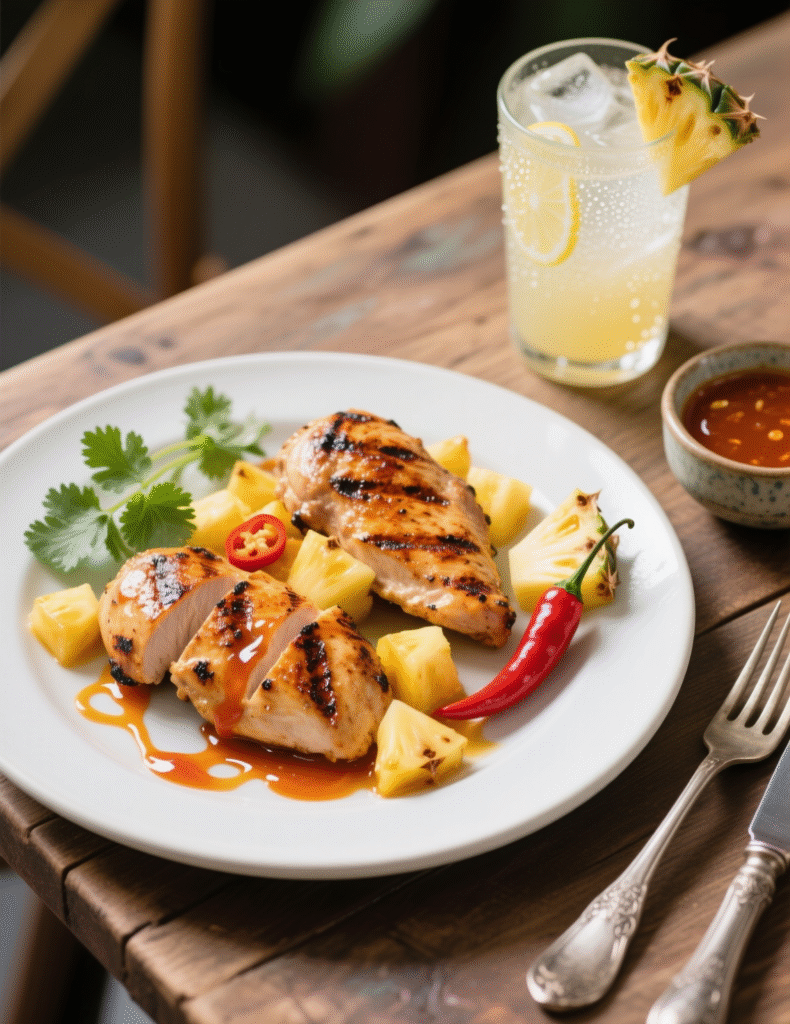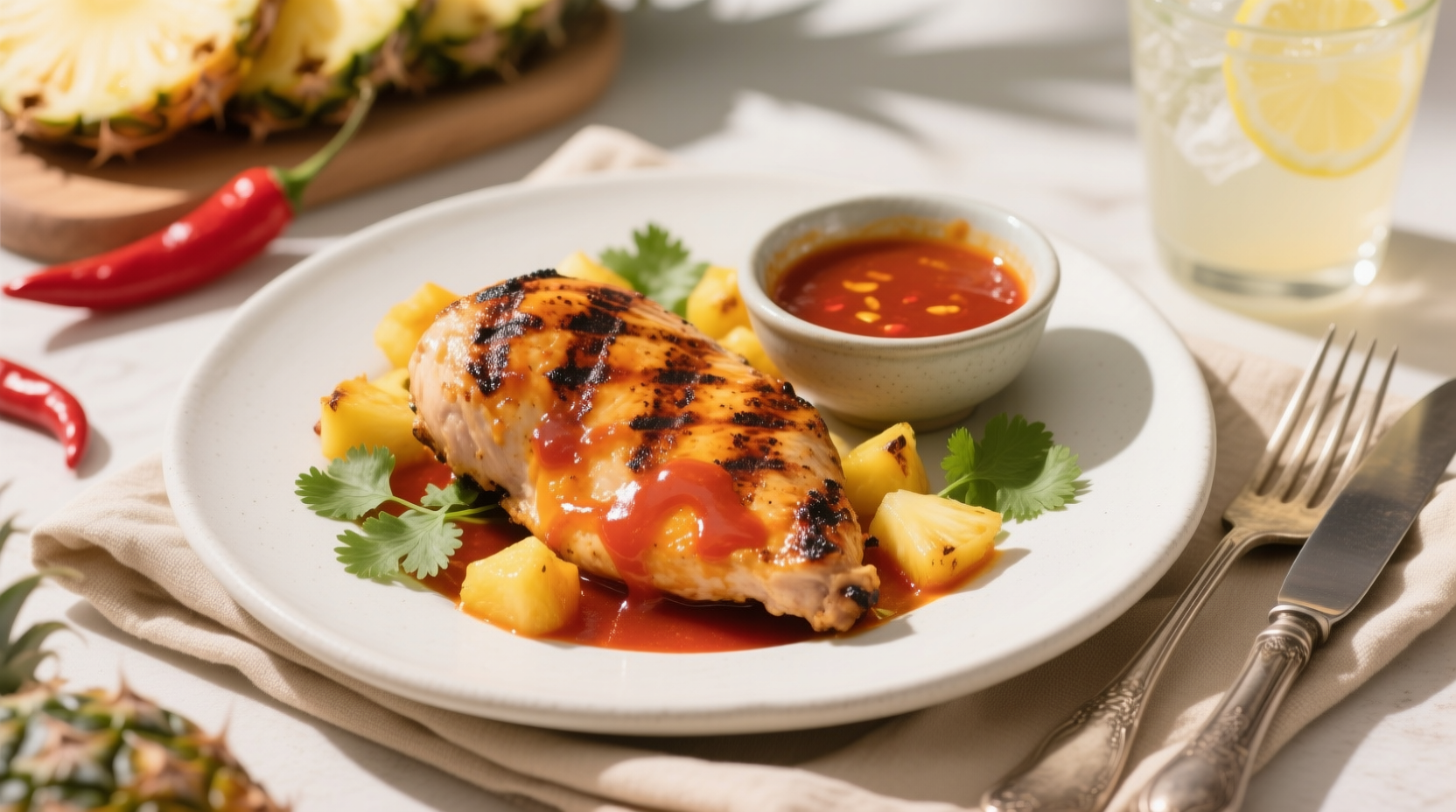Every once in a while, a dish comes along that makes you stop mid-bite and wonder—how did someone even think of this? Chili Pineapple Grilled Chicken is that dish. It’s a symphony where tropical sweetness leans on the shoulder of fiery spice, and they both laugh together over smoky grill marks. For professional chefs, it’s a playground of texture, temperature, and flavor balance. For home cooks, it’s a weekend showstopper. And for me, it’s one of those recipes you keep making until the cutting board smells like pineapple juice forever.
Why This Combination Works So Well
Sweet and spicy aren’t just friends—they’re conspirators in flavor chemistry. Pineapple is naturally rich in bromelain, an enzyme that tenderizes meat. When used in a marinade, it doesn’t just soften the chicken—it changes the way it interacts with heat. You get that tender, almost buttery bite, but still with a charred edge from the grill. The chili—whether you choose fresh red chilies, chipotle, or chili flakes—cuts through that sweetness and adds an addictive kick.
There’s also a cultural nod here. Dishes from Southeast Asia, the Caribbean, and even Mexico lean heavily on sweet-and-spicy pairings. Think Thai sweet chili sauce, Jamaican jerk chicken, or Mexican pineapple salsa. The technique isn’t new, but its versatility is where it shines.
The Foundation: Selecting the Right Chicken
Not all chicken is created equal for grilling. Bone-in thighs hold moisture better, giving you richer flavor. Boneless breasts cook faster but need extra marinade care to avoid drying out. Professionals often go skin-on, as that extra fat layer helps keep the meat juicy while adding a crisp, smoky bite.
For large-scale service—say, catering or a restaurant special—thighs are your safe bet. They have more forgiving cook times, so you can focus on that perfect char without panic-checking the internal temp every two minutes. For a plated fine-dining approach, breasts sliced against the grain with a glossy glaze drizzled over? Absolute showpiece.

Building the Marinade: More Science, Less Guesswork
The backbone of this recipe is a good marinade. The pineapple brings bromelain, but leave chicken sitting in pure pineapple juice too long and it can over-tenderize, leading to a mushy texture. The sweet spot is usually 2 to 4 hours for boneless cuts, and up to 6 for bone-in.
A balanced professional marinade might look like this:
- Fresh pineapple juice (never canned, as pasteurization dulls the enzyme)
- Red chili paste or fresh minced chili
- Garlic, finely grated
- Ginger, for that sharp, bright note
- Brown sugar or honey to deepen the caramelization
- Soy sauce for umami depth
- A touch of rice vinegar or lime juice for acidity balance
Emulsifying the marinade—blending oil into it—ensures an even coating and better sear on the grill. This is where most home recipes miss the mark. Oil acts as a conductor, carrying the heat evenly while also helping the sugars caramelize instead of burn.
Prepping for the Grill
Chefs will tell you: meat goes on the grill dry, not dripping in marinade. Excess marinade burns fast, creating bitterness. Pat the chicken dry, then brush with a light coat of fresh oil. Keep some marinade aside before adding raw chicken—this becomes your glaze later.
Temperature control is everything. You’re not throwing it over roaring flames and hoping for the best. Start with medium-high heat to sear and create grill marks, then shift to indirect heat to finish cooking. This gives you that char without scorching the sugars in the pineapple juice.
The Magic of Glazing
Glazing mid-grill is where you turn good into great. Every time you glaze, you build another layer of flavor. But patience is your friend here—glaze too early and it burns, glaze too late and it won’t set. The sweet spot is about halfway through cooking.
In professional kitchens, a small brush is used to control coverage, ensuring the glaze caramelizes evenly. You want it sticky, glossy, and clinging like it doesn’t want to leave the chicken. That’s the point where the sugars are locking in the chili heat, and the pineapple sweetness is mingling with the grill smoke.

Pairing and Plating for Maximum Impact
Plating isn’t just about looks—it’s about guiding the diner’s bite. Pineapple salsa with red onion, cilantro, and a touch of jalapeño on the side keeps the tropical theme alive while adding freshness. Grilled corn with chili butter? Perfect textural counterpoint.
In high-end dining, you might slice the chicken on a bias, fan it out over coconut rice, drizzle with reduced glaze, and scatter micro herbs over the top. For a more rustic approach, serve it straight from the grill on a wooden board with charred pineapple wedges and lime halves.
Common Mistakes (and How Pros Avoid Them)
One big mistake—over-marinating. Pineapple’s bromelain works faster than people think. Another? Cooking over heat that’s too high, which burns the sugars before the chicken is done. Professionals mitigate this by setting up a two-zone grill: one side for searing, one for finishing.
Also, don’t forget carryover cooking. Chicken pulled off the grill at 160°F will climb to 165°F while resting. Pulling too late dries it out. Resting under foil for 5 minutes allows juices to redistribute—non-negotiable if you want consistently moist meat.
Nutrition and Modern Menu Trends
This dish fits beautifully into modern dining trends. It’s naturally gluten-free if you swap soy sauce for tamari. Pairing lean chicken breast with pineapple also appeals to health-conscious diners looking for high-protein, low-fat meals. Add chili’s metabolism-boosting properties, and you have a dish that can be marketed as both indulgent and health-forward.
On the sustainability side, working with free-range or pasture-raised chicken not only supports ethical farming but also produces meat with better texture and flavor. Some chefs also opt for smaller chicken breeds to reduce cooking time and portion size without sacrificing satisfaction.
Step-by-Step Expert Recipe
Ingredients (Serves 4)
- 4 chicken breasts or thighs (bone-in or boneless, skin optional)
- 1 cup fresh pineapple juice
- 2 tbsp fresh red chili paste (or 2 fresh chilies, minced)
- 3 garlic cloves, grated
- 1 tbsp grated fresh ginger
- 2 tbsp brown sugar or honey
- 3 tbsp soy sauce or tamari
- 1 tbsp rice vinegar or lime juice
- 2 tbsp neutral oil (plus extra for brushing)
- Fresh cilantro and lime wedges, for garnish
Method
- Blend pineapple juice, chili paste, garlic, ginger, sugar, soy sauce, vinegar, and oil into a smooth marinade.
- Reserve ½ cup marinade in a separate bowl for glazing.
- Place chicken in a shallow dish or resealable bag, pour over marinade, and refrigerate for 2–4 hours (breasts) or 4–6 hours (thighs).
- Preheat grill to medium-high heat, set up two zones.
- Pat chicken dry, brush with oil.
- Sear over direct heat for 2–3 minutes per side to create grill marks.
- Move to indirect heat, brush with reserved marinade, cover grill, and cook until internal temp reaches 160°F.
- Brush again with glaze, rest 5 minutes before serving.
- Garnish with cilantro, serve with lime wedges and pineapple salsa.
Final Thoughts
Chili Pineapple Grilled Chicken isn’t just a recipe—it’s a conversation on the plate. The heat makes you sit up. The sweetness keeps you leaning in. And the grill smoke wraps it all up in something primal and satisfying. It’s versatile enough for casual summer cookouts and refined enough for a white-tablecloth menu.
Professionals know—it’s the details that elevate this from a backyard dish to a signature menu item. The right marinade time. The right grill heat. The patience with the glaze. Every bite should tell the story of a cook who knows their fire, their fruit, and their chili.
FAQs
What cut of chicken works best for Chili Pineapple Grilled Chicken?
Bone-in thighs for juiciness, breasts for a leaner, faster-cooking option.
How long should I marinate the chicken?
2–4 hours for breasts, 4–6 hours for thighs to avoid over-tenderizing.
Can I use canned pineapple juice?
Fresh is best—canned loses the tenderizing enzyme bromelain.
How do I stop the marinade from burning?
Pat the chicken dry before grilling and cook over medium-high, not direct high heat.
When should I glaze the chicken?
About halfway through cooking, so it caramelizes without burning.
What internal temperature should the chicken reach?
160°F before resting, which will rise to 165°F with carryover cooking.
Can I make this dish gluten-free?
Yes, just swap soy sauce for tamari.
What sides pair well with this dish?
Pineapple salsa, grilled corn, coconut rice, or fresh greens.
Is this recipe suitable for meal prep?
Yes, it stores well for 2–3 days and reheats without losing flavor.
Can I cook this without a grill?
Yes, a grill pan or broiler works, though smoke flavor will be less intense.

Mariana is a passionate home cook who creates delicious, easy-to-follow recipes for busy people. From energizing breakfasts to satisfying dinners and indulgent desserts, her dishes are designed to fuel both your body and hustle.
When she’s not in the kitchen, she’s exploring new flavors and dreaming up her next recipe to share with the Foodie Hustle community.

